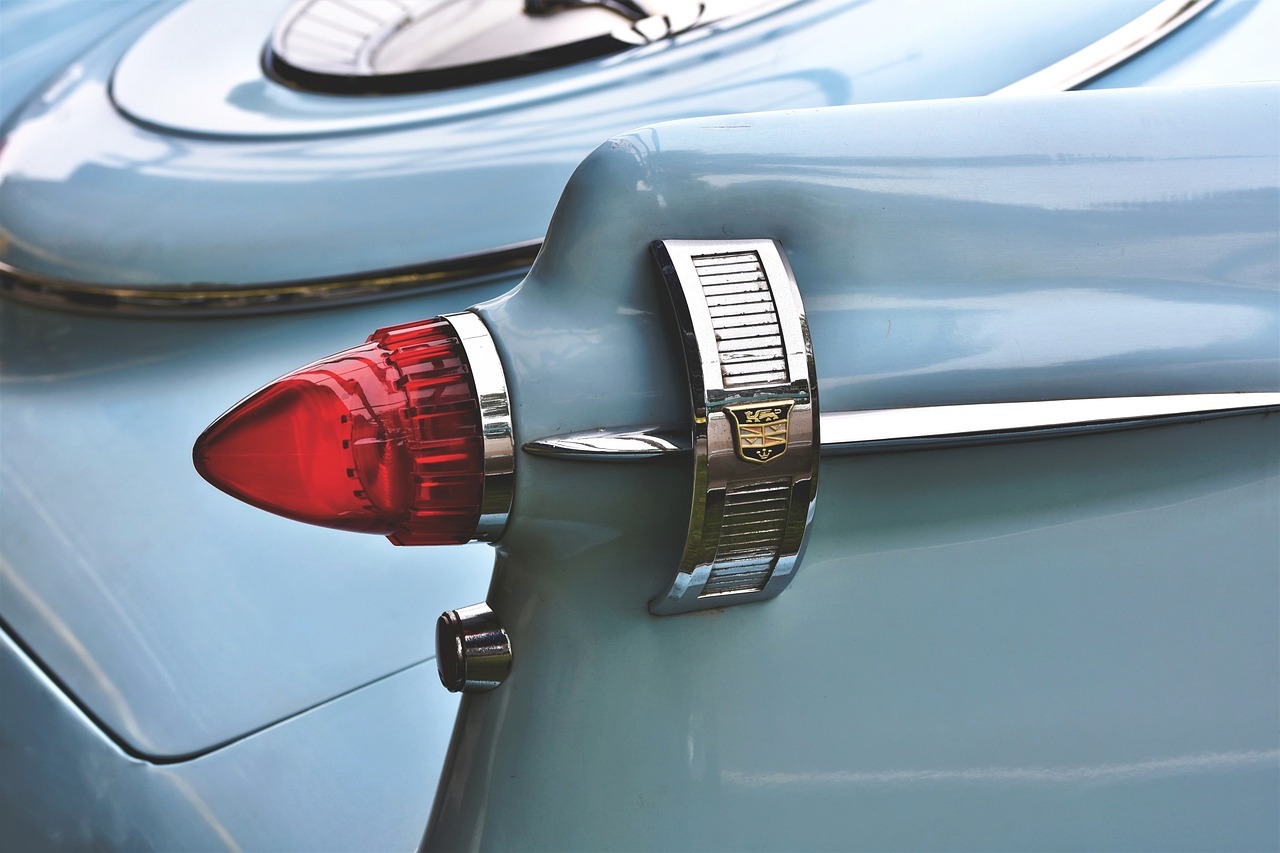Car tail fins, those sleek, stylish extensions jutting from the back of vintage automobiles, have a timeless allure. These distinct automotive features from the mid-20th century are more than just aesthetic additions; they tell a fascinating story of design, engineering, and the American Dream. This blog will uncover the history of car tail fins, their main purpose, and how they evolved to the modern world of automobiles.
The Purpose of Car Tail Fins
Tail fins serve multiple purposes on a car, apart from just giving your car an extra design. They are engineering marvels that enhance both stability and aerodynamics.
Enhancing Stability
Tail fins act as stabilizers for a car, especially at high speeds. Without them, a vehicle can feel less secure on the road. Picture driving down the highway on a windy day. Tail fins help counteract the side forces from wind and sudden movements, preventing your car from swaying like a leaf in the wind. This steadying effect is essential for maintaining control and ensuring a safe, predictable ride.
Improving Aerodynamics
Now, let’s talk about how tail fins boost a car’s aerodynamic performance. These sleek extensions are not just for show; they are carefully designed to cut through the air with minimal resistance. This design significantly reduces aerodynamic drag (the force that opposes the motion of your vehicle). As a result, your car becomes more fuel-efficient. In fact, the reduction in air resistance can save you up to 10% in fuel, a notable figure for anyone looking to cut down on fuel expenses.
Aiding Against Crosswinds
Another fascinating function of tail fins is their ability to act like a rudder on a ship. When driving in adverse conditions, such as strong crosswinds, tail fins come to the rescue. They help maintain your car’s course and prevent it from getting pushed around. This feature ensures a safer and more predictable driving experience, especially when you least expect it
Enhancing Brake and Light Visibility
Tail fins can also improve the visibility of a car’s brake lights and turn signals. When tail fins are designed to extend slightly over the rear lights, they can act as a shade, reducing glare from sunlight or oncoming headlights. This ensures that the brake and turn signal lights are more visible to other drivers, enhancing safety on the road.
History of Tail Fins: When Were They Popular?
Tail fins became more than just car features; they became emblematic of the era’s cultural and social aspirations.
Emergence in the Late 1940s
Tail fins made their first appearances in the automotive world in the late 1940s. General Motors, a major player in the American car industry, can be credited with introducing this trend. In 1948, Cadillac unveiled the Cadillac Series 62, which featured small, subtle tail fins. This marked the beginning of a design revolution that would later define the 1950s and early 1960s.
Height of Popularity in the 1950s (Most Popularity)
The 1950s witnessed the peak of tail fin popularity. It marked a significant shift in the American psyche. The gloom of war had lifted, and the nation was infused with a renewed sense of optimism. Returning soldiers were eager to embrace a more prosperous and peaceful future. It was an era defined by rapid economic growth, the rise of the middle class, and a desire for modernity.
The Chevrolet Bel Air with its striking tail fins was more than just a car; it became a cultural emblem. It embodied the American Dream – the idea that anyone could achieve success and prosperity. Owning a car like the Bel Air was a status symbol, reflecting the newfound affluence and optimism of the post-war years. The car’s futuristic appearance mirrored the era’s enthusiasm for progress and innovation.
The 1950s was a time when the promise of a brighter future was not only visible on the horizon but also showcased in the driveways of many American families. The eye-catching tail fins of cars like the Bel Air symbolized this collective hope. They represented the idea that technology and design could propel society forward, leaving behind the hardships of the past.
Competitive Spirit among Automakers
During the 1950s, there was a fierce competition among American car manufacturers to outdo each other in terms of design. Each year saw more extravagant and towering tail fins as automakers vied for consumer attention.
In this fervent atmosphere of design one-upmanship, automakers engaged in an annual race to outdo their own creations and those of their competitors. Tail fins, initially a subtle and functional feature, were transformed into a canvas for designers to showcase their creativity. What began as a modest, stabilizing element became an iconic symbol of automotive excess.
While the entire decade witnessed this escalating tail fin frenzy, 1959 stands out as the year when the competition reached its zenith. Cadillac, a brand known for its bold designs, introduced the Cadillac Eldorado, a car that sported the largest and most ornate tail fins ever seen on a production vehicle. These fins were not just a design choice; they were a statement.
The Cadillac Eldorado’s tail fins soared to new heights, seemingly touching the sky. They were adorned with intricate chrome details and lights, creating a spectacle that captured the imagination of car enthusiasts and the public alike. These enormous tail fins weren’t just for show; they also served to amplify Cadillac’s reputation for luxury and extravagance.
In many ways, the 1959 Cadillac Eldorado represented the climax of the tail fin craze. It embodied the audacious spirit of the decade, where bigger, bolder, and more extravagant were the norms. However, it also marked the beginning of the end for tail fins, as the 1960s brought about a shift towards sleeker, more understated car designs.
Cultural and Social Significance
Tail fins became cultural icons, symbolizing progress and prosperity. They were a reflection of the economic prosperity of the time, and owning a car with impressive tail fins became a status symbol. In 1959, Chevrolet even ran an advertising campaign titled “Jet Smooth Chevrolet” to emphasize the connection between tail fins and modernity.
Decline of Tail Fins
The 1950s was an era of iconic tail fins, but as the 1960s dawned, these distinctive features began to lose their prominence. Several factors contributed to the decline of tail fins, marking a transition towards more modern car designs.
Changing Consumer Tastes
By the early 1960s, consumer preferences were shifting. The excesses of the tail fin era had started to wear thin, and buyers began to desire sleeker, more understated designs. The grandiose, towering tail fins of the late 1950s seemed less appealing in the face of evolving aesthetics.
Economic Pressures
The early 1960s saw economic challenges, including rising fuel costs and concerns about fuel efficiency. The large tail fins of the 1950s were seen as less practical and fuel-efficient. Consumers became more conscious of operating costs, and automakers responded by pursuing streamlined designs.
Safety Concerns
Tail fins, while aesthetically pleasing, raised concerns about safety. In the event of a rear-end collision, the protruding fins could potentially cause more damage to other vehicles or pedestrians. Safety considerations gained prominence in the design of automobiles, leading to a reevaluation of tail fins.
Advancements in Engineering
Advancements in automotive engineering allowed for better handling and performance without relying on tail fins for stability. Improved suspension systems, tires, and aerodynamic research made tail fins less essential for ensuring a smooth and controlled ride.
Key Transitions
The early 1960s marked the first signs of change. In 1960, Cadillac, a brand known for its extravagant tail fins, began to reduce the size and prominence of these features in response to evolving tastes and economic pressures.
Ford, another major player in the automotive industry, followed suit in 1961 with the release of the Ford Thunderbird, which had more modest and understated tail fins compared to its predecessors.
By the mid-1960s, tail fins had largely disappeared from mainstream car designs. Notable models from that period, like the 1965 Ford Mustang and 1966 Chevrolet Impala, featured cleaner, more aerodynamic lines.
Conclusion
In the story of cars, the era of tail fins was a flashy period that represented the American Dream and the desire for progress. These tall, stylish extensions on cars in the mid-1900s reflected a society moving past the effects of war, embracing prosperity, and reaching for new horizons. But, just like fashion trends change, people’s interest in tail fins faded. This happened because people wanted simpler car designs, costs were rising, and there were safety concerns. So, in the 1960s, tail fins started disappearing from cars. Yet, they left a mark, reminding us of a time when cars were more than just vehicles; they were a statement of our hopes and dreams.



